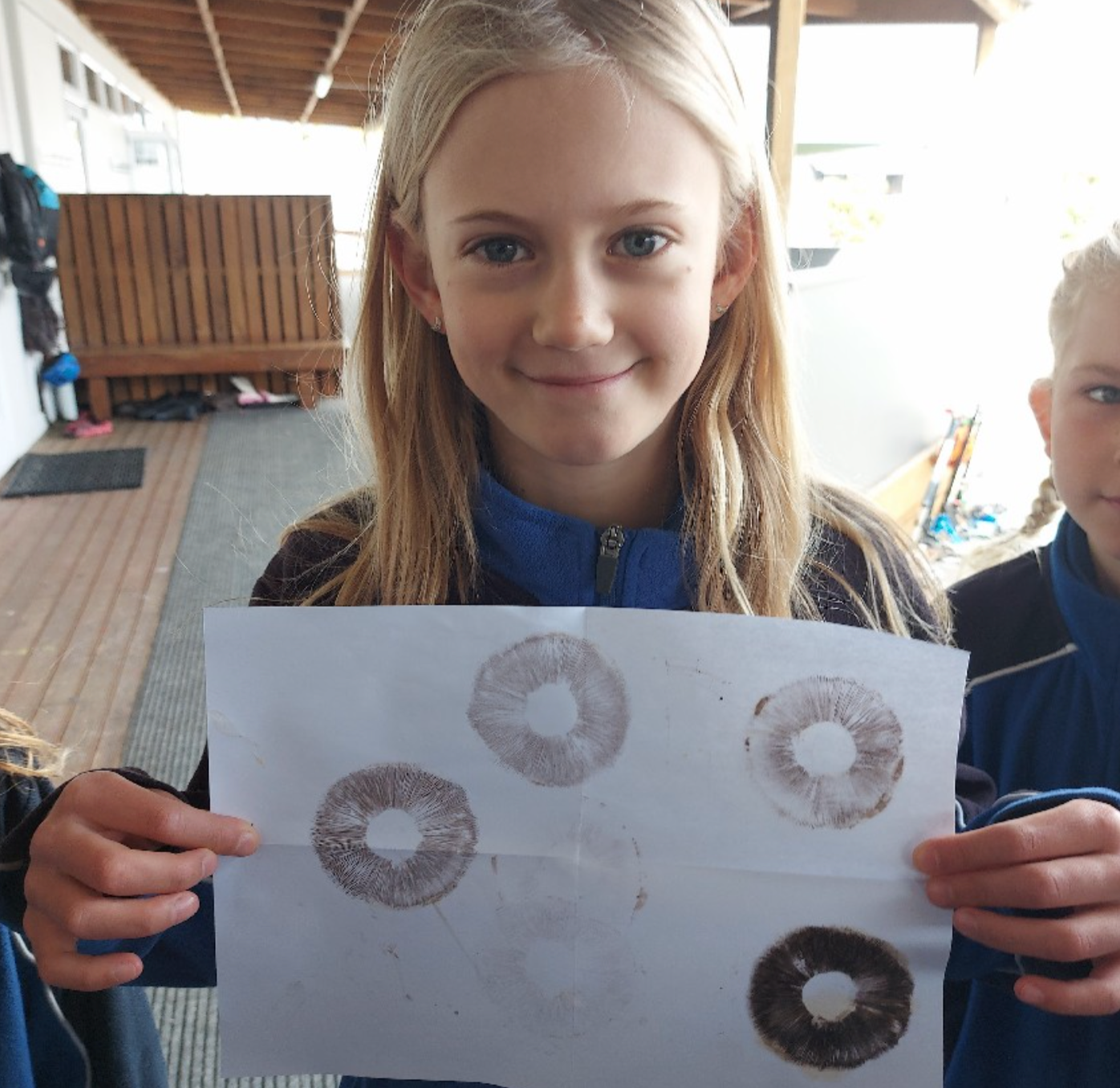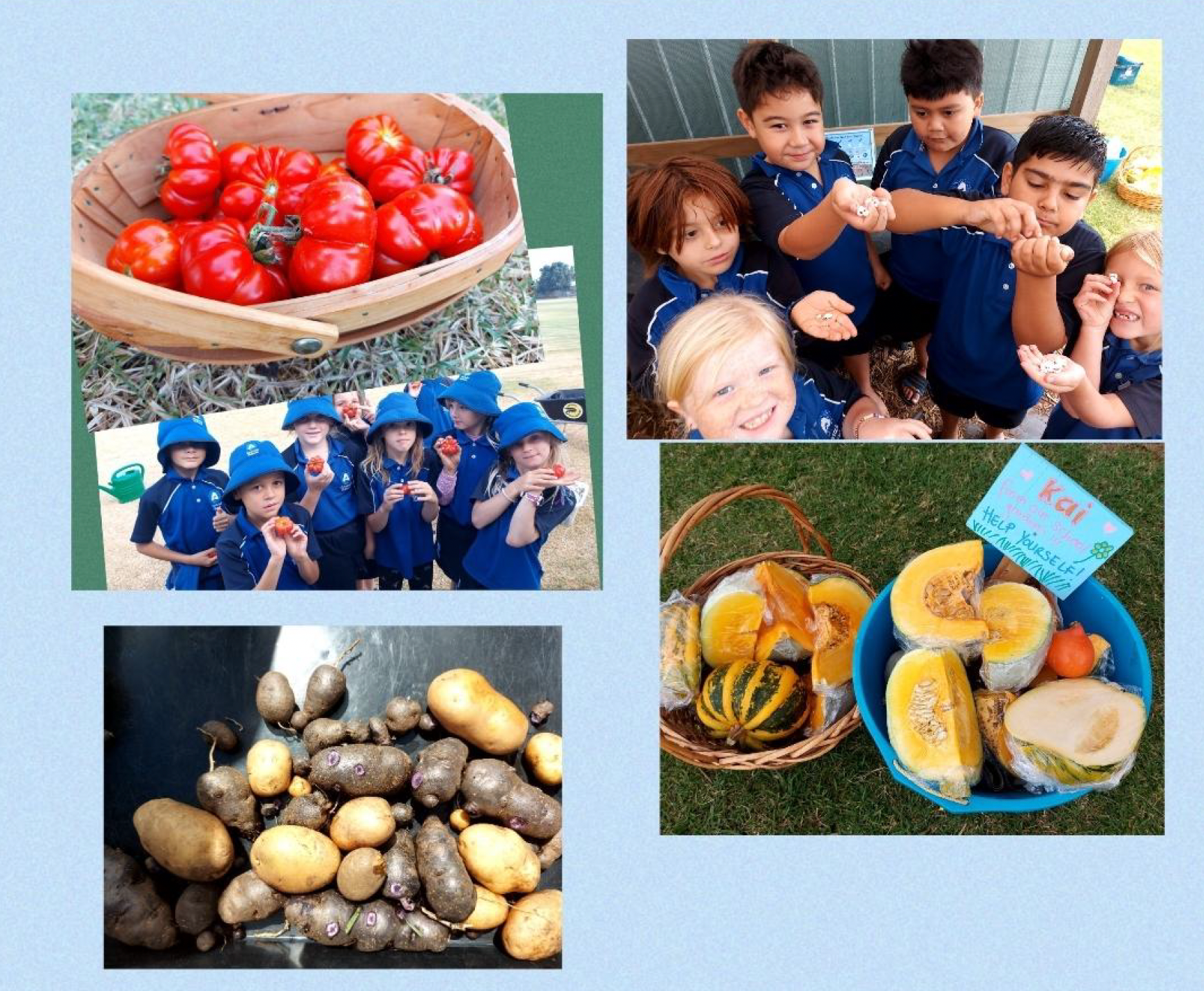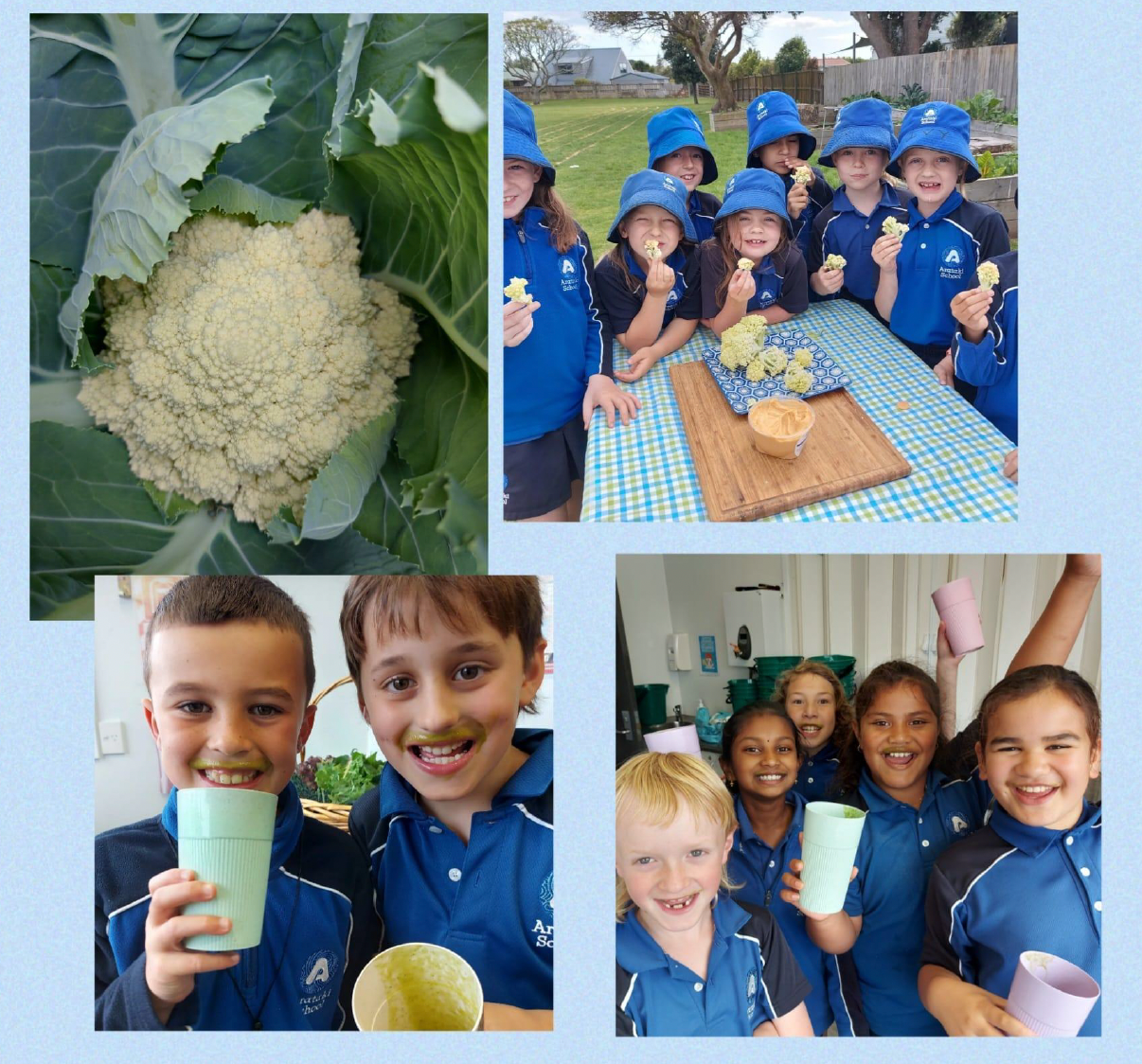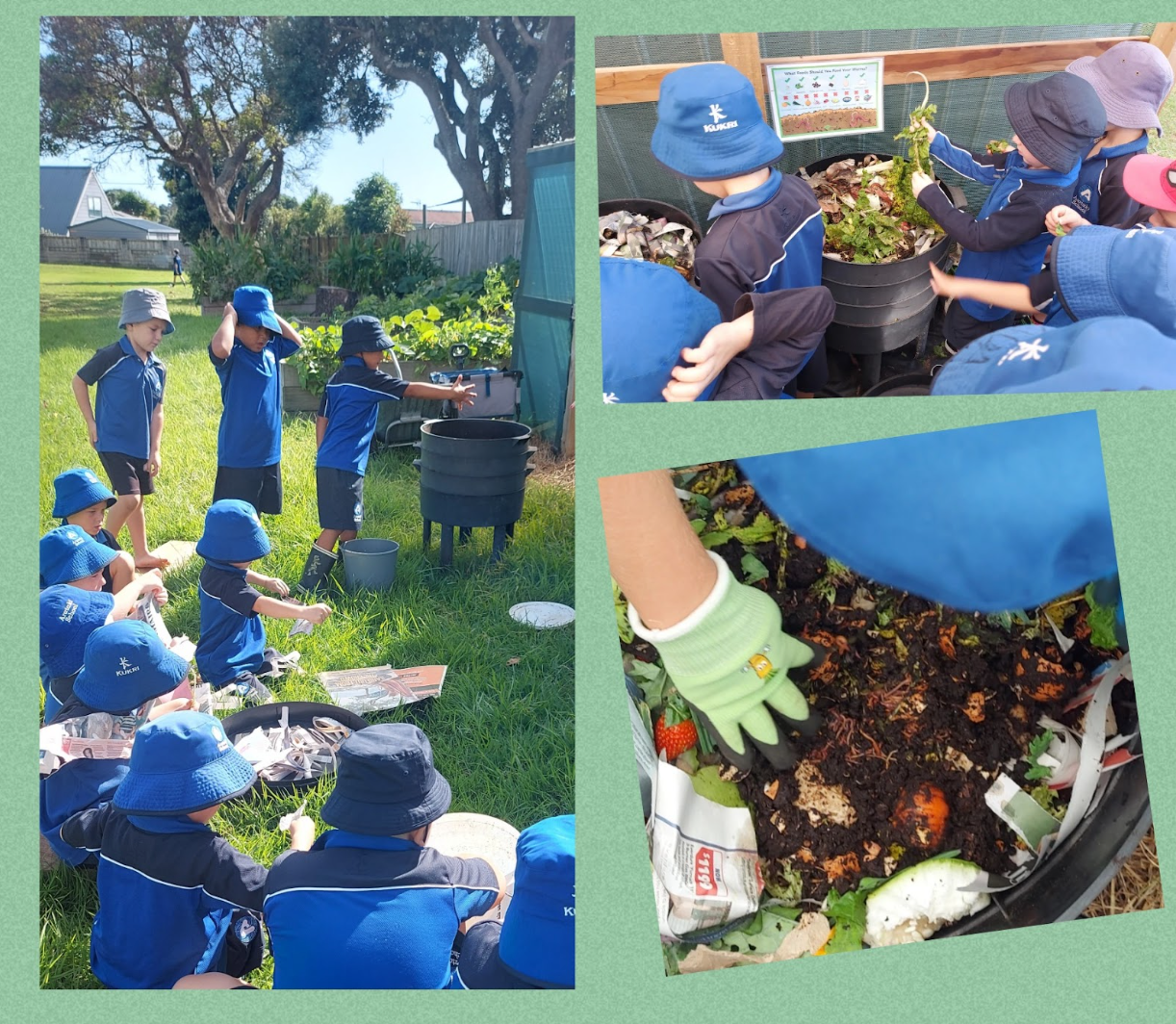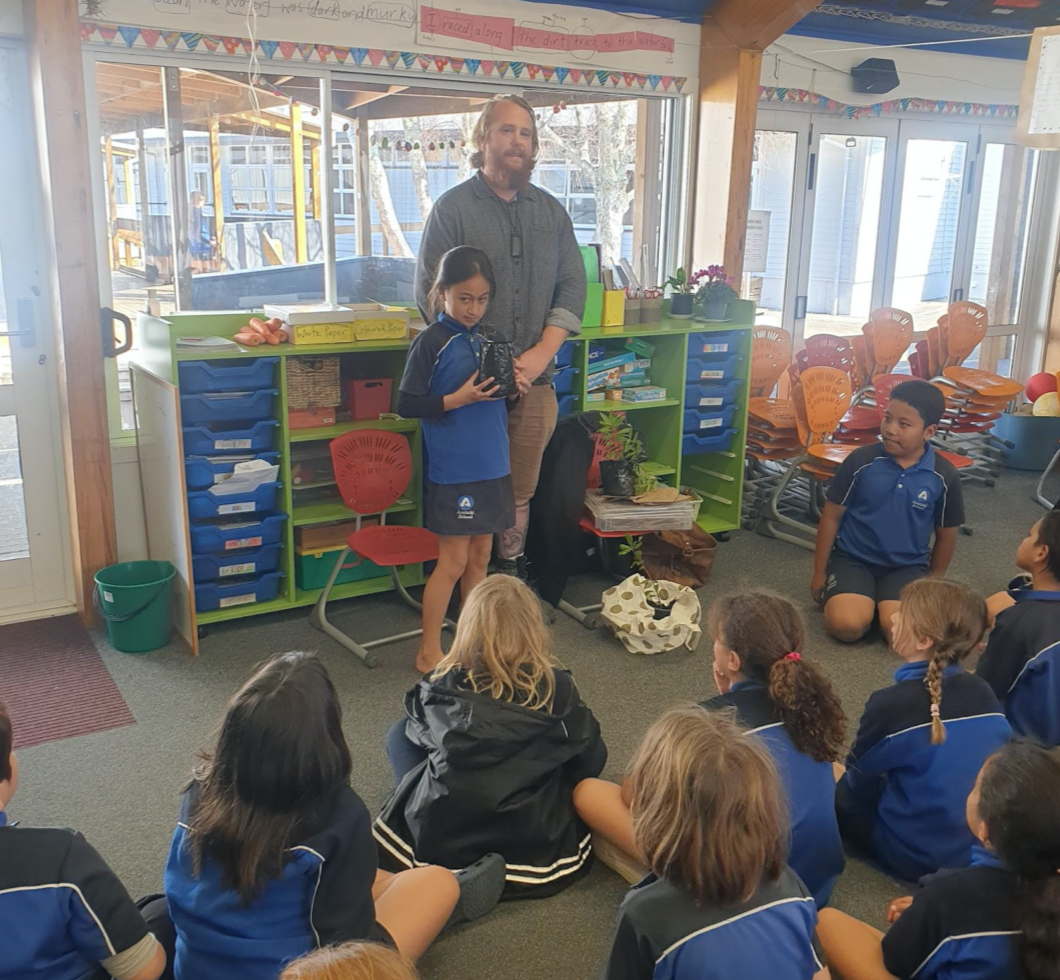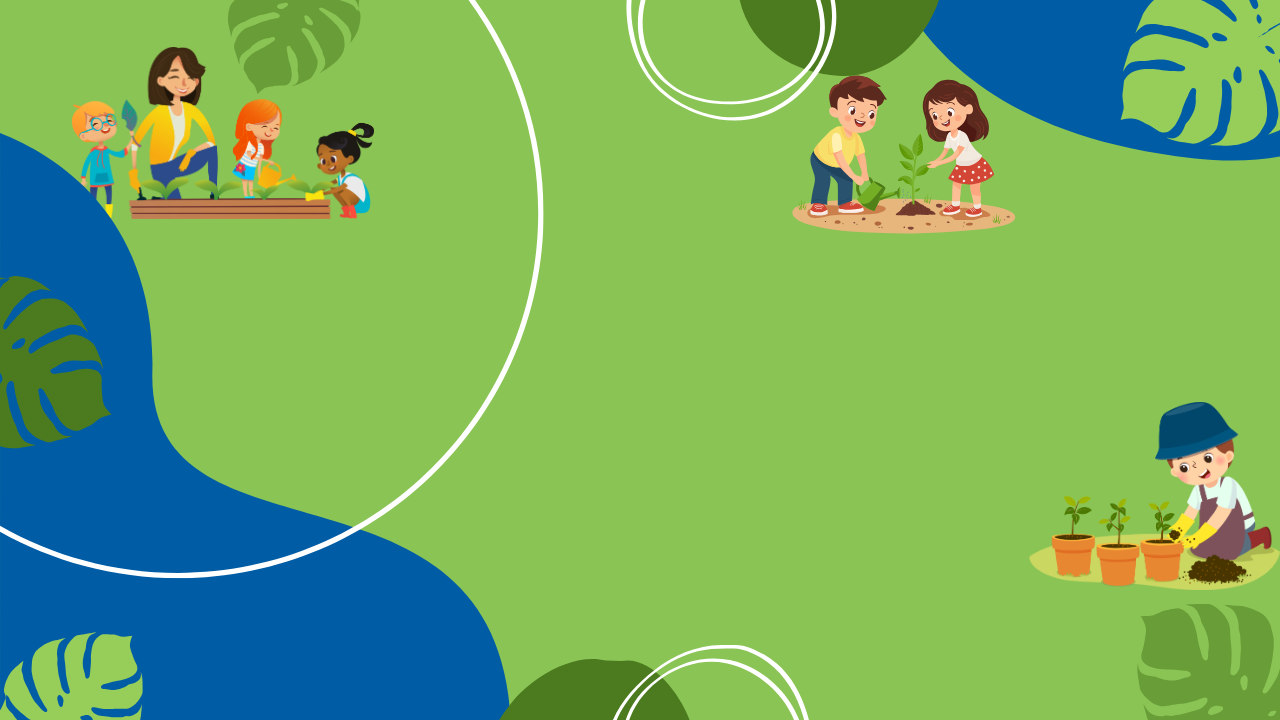
Kia ora from Arataki School!
Welcome to our school’s garden blog! Here at Arataki School, our tamariki are hands-on in the māra–planting, harvesting, composting, and learning about sustainability and food resilience. This page is where we share our highlights, harvests, cooking adventures, and discoveries in the garden. Follow along as our little gardeners grow!
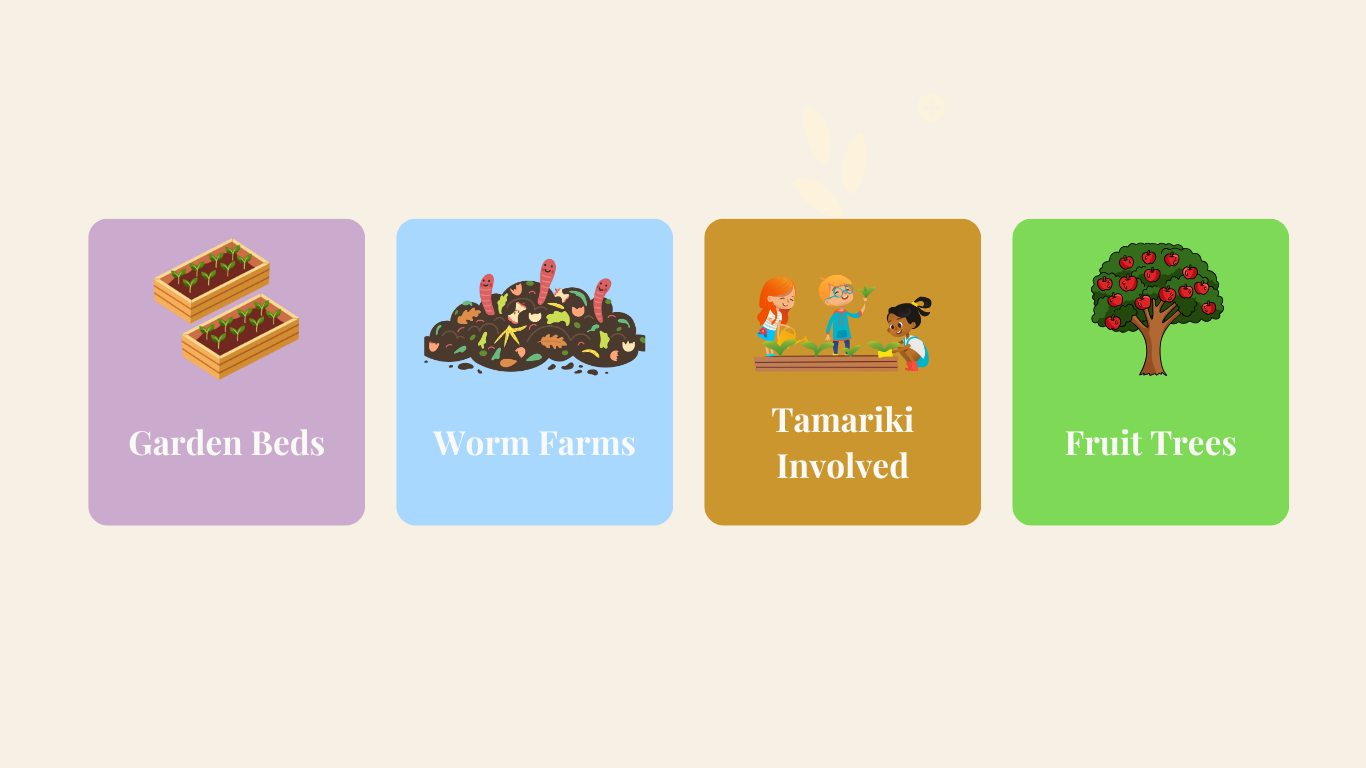
Welcome to our blog!
School Gardens Term 1, 2025
In term 1, we worked with New Entrant gardeners and a senior class. We started by introducing the gardens – the worm farms were a big hit, and the young gardeners loved feeding them every week. They soon learned that worms and their castings aren’t smelly or dirty but clever composters that turn food waste into healthy soil!
We planted bean seeds in pots for kids to care for in class. They loved watching beans sprout in zip lock bags. After a few weeks, seedlings were big enough to plant in tipis made from stakes. Then, we cleared the summer garden and planted beetroot and silverbeet seedlings. Kids added compost and watered weekly!
They helped chop our pumpkins to share with our school whanau from the pataka kai in their classroom with Matua Mike. Diane showed us a great trick using her bone-handled butter knife, which cut the tough pumpkins really well!
The dry summer helped us collect many dry seed heads for saving—a great job for little hands. Our gardeners enjoyed comparing the different seed shapes and sizes. Marshmallow flower seeds were the favourite—they look like tiny donuts! We made origami envelopes to keep our seeds so we can plant them again next year.
During this hot, dry term, our lunchtime gardeners, led by Lukas, tirelessly watered the gardens at least once a week. The snail vine creeper is thriving and flowering beautifully!
Our seniors worked hard caring for the fruit trees. They pulled kikuyu grass from around the tree bases and made sure the mulch didn’t hurt the bark. Then, they mixed worm castings from our worm farms with water to make buckets of rich, organic liquid feed for the trees.
The term’s highlight for our young gardeners was harvesting and cooking strawberry popping corn on the garden shed stove! They loved the ruby red cobs, sang songs, and said, “This is how they do it in the movies!”. They happily shared their popcorn!
School Gardens Term 4, 2024
We warmly welcomed our Hikurangi classes to the gardens in Term 4, and they were bursting with enthusiasm! With the Garden and Art Festival coming up in week 4 of the term, there was a whole lot to be done to prepare everything perfectly. We wanted to ensure that we could share all the wonderful things we do in the gardens with our visitors, most excitingly and engagingly as possible.
In Term 4, our Hikurangi classes visited the gardens and were very excited! With the Garden and Art Festival in week 4, we had a lot to prepare to show visitors what we do.
This term, we cleared beds to plant sunflowers, strawberry popping corn, beans, and squash—they’re thriving! Soon, we'll use a camping stove to make popcorn once the cobs dry.
To end before Christmas, our young gardeners made beautiful air-dried clay decorations with plant designs. Hopefully, they all got home safely!
Before the festival, Friends of the School held a working bee Sunday. Fences were painted black, fruit trees got wooden surrounds, hand-painted signs, and mulch. Lots of weeding and watering done. Many hands make light work.
Our tree stump flower gardens thrive with sweet peas, lavender, and calendula, loved by butterflies and bees. Thanks to the neighbour’s hive, visiting bees pollinate our gardens, boosting fruit and veg growth!
Visitors at the four-day Garden and Art festival were impressed by the young gardeners. They learned slug traps, strawberry decoys, companion planting, seed saving, and more! The feedback was fantastic.
Our strawberry beds are thriving with bumper summer harvests. Mounded rows topped with wool mulch work best! Lunch gardeners enjoyed tastings, leaving with juicy strawberry beards and full tummies!
School Gardens Term 3, 2024
This term, Tuesdays were spent with the Montessori and Kopukairoa classes, and we made great progress in the gardens. Our first task was to move the Sentinel Garden across the field. After digging, moving many wheelbarrow loads of soil, and carefully carrying plants, we got help from Brian to roll the kiwifruit bin to its new place by the garden beds. It’s amazing how quickly we can finish tasks when we work together!
We refreshed the strawberry beds with Arataki School compost, planted strawberries in raised rows, mulched with wool packaging, and placed painted riverstone decoys to deter birds.
A big thanks to Resene for donating many test pots for the project! Each mushroom will have a QR code linking to info about that fungus. The students loved it, and one gardener even made a mushroom spore print at home to share with us the next week!
Rainy days led us to learn indoors about potatoes and chitting. We placed seed potatoes under woolly mulch in trays in the garden shed, checking sprouts regularly.
We’ve harvested lots of beautiful romanesco broccoli and big cauliflower heads. Some gardeners were surprised how good they taste raw, especially with hummus! One day, they ate five big heads while snacking in the garden!
This term, we learned about Aotearoa’s fungi. Gardeners shared stories of rare finds like stinkhorn and basket fungus. We're creating a garden project with painted wooden stumps and fruit bowls near the sensory garden to showcase NZ fungi.
Our summer veggie garden project is fun! We’re prepping two pea straw bales with water and worm castings for nitrogen. In week 1 of term 4, we’ll plant seedlings in them. The straw warms the soil and breaks down, boosting growth. We’ll also grow a regular garden nearby to compare.
School Gardens Term 2, 2024
Ruma 13 from Kopukairoa teamed up with the wonderful students from Mangatawa this term to look after and nurture the school gardens together.
At the beginning of the term, they had a fun treasure hunt, digging in the garden beds, and managed to fill a basket with kumara to share with the school community at the front of the school.
Rainy days taught us about garden birds, especially natives. The kereru, with its white chest, big belly, and berry tumbles, was a favourite. The piwakawaka charmed us with its call and bush-following ways. One gardener said his nana is a piwakawaka, always nearby.
After adding rich black soil from Te Puke Landscapes, we planted carrots in neat rows, watered them well, and planted cauliflower, broccoli seedlings, plus broad beans, snow peas, and sugar snap peas directly into the beds.
The gardeners truly loved the birds and enjoyed colouring them with bright, vibrant shades. They also enthusiastically took part in the NZ bird survey during the last week of the term, carefully observing and recording the different species they saw.
This term, PiPS teamed up with Arataki School and got funding from Tauranga City Council for a rainwater system. It will water the gardens and the sandpit/water play area. Installation is set for term 4, so watering seedlings will be easier and more fun with rainwater!
School Gardens Term 1, 2024
This term, it was the enthusiastic students from Hopukiore and Mauao who joined me in the gardens every Tuesday, with plenty of keen beans from other classrooms popping in at lunchtimes as well to get their hands dirty and learn more.
After a sunny, dry summer, we began term 1 with seed saving. Perfect dry weather let us collect broccoli, kale, snapdragons, sunflowers, and more! We then labelled and stored the seeds in envelopes in our shed’s seed box for next season.
At first, I doubted, but our gardeners were amazing! They planned, measured, designed, and did the hard work—carrying bricks, weeding, and moving mulch. Proud of these tamariki! Well done, team!
It also meant good harvests: plenty of tasty tomatoes eaten fresh, spuds taken home, pumpkins shared for the kai cart. But popping their shadehouse-grown corn was the favourite—yum!
This term, we finished pathways in the sensory gardens using salvaged bricks, bark mulch, and pumice from Te Puke Landscape Supplies to give tamariki varied sensory experiences underfoot.
School Gardens Term 4, 2023
The students from Hopukiore and Mauao have been very busy in the gardens this term. Now that the growing season has kicked off, they have been enjoying the harvest! Awesome to see our tamariki getting so excited about devouring their greens!
We’ve grown big, beautiful hybrid cauliflowers and made hummus to eat with fresh cauli pieces from the garden. They’ve also enjoyed celery and some early strawberries!
Our shade house is full of seedlings—sunflowers, capsicum, herbs, and gourds—ready to be planted before term’s end for holiday growth. Our upcycled milk bottle watering cans help, as gardeners regularly care for their seedlings.
Late this term, our year 5 and 6 students joined the Arataki Park Fruit Forest project. Invited by Tauranga Kai Resilience and Tauranga Council, we helped care for the community orchard. We met arborists Mark and Heme, who shared their love of trees. Next year, we'll make signs for the trees.
On rainy days, we made green smoothies with kale, mint, spinach, and silverbeet from the school gardens! Tamariki loved their greens! The office ladies tried the smoothies, and teachers enjoyed a veggie and hummus platter from the gardens.
After harvesting, we let our vegetable plants flower and seed. Though the garden looks wilder, it benefits bees and pollinators. We dry seed pods in the shade house and save seeds to replant next year.
Our two compost bays turn garden waste, shredded paper, and coffee grounds into rich compost, reducing the need for new soil. Our worm farms produce organic liquid fertiliser, or worm wee. Tamariki are learning soil health, seen in our big cabbages, cauliflower, and kale.
Each garden bed has an ‘olla,’ an ancient terracotta watering system that slowly seeps water into the soil, encouraging deeper roots to survive dry months. The tamariki decorated the ollas and used the lids as bee watering stations and bird baths.
School Gardens Term 3, 2023
The students from Kopukairoa have done great work in the gardens this term. For the first three weeks, they worked with Whaea Emma on composting and why worms are important. They also planted green manure to keep the soil healthy. Maeve was happy to come back and see so many eager gardeners.
These wonderful gardeners loved watering the veggies and feeding them worm juice from our worm bins. We also emptied a compost bin full of rich soil into the garden beds! Their gentle hands and happy spirits help our gardens grow healthy and strong. Every drop counts in caring for our little plants. Great job, tamariki!
A few wet days this term meant indoor fun: we made bird feeders for garden visitors and seed bombs for wildflowers around the neighbourhood. The ‘bombers’ will report back on their success.
This term, we focused on gardening with the Maramataka Calendar. Gardeners made Maramataka wheels to learn how planting, feeding, watering, and harvesting by moon phases benefits organic gardening. This cycle helps us work with the garden's slow and busy times, using slower periods for preparation.
Over the holidays, the compost bay will be rebuilt as the untreated pallets wear out. Soon, two compost bays will be ready. Meanwhile, worm farms turn food waste into liquid gold for seedlings. We also aim to install a basic watering system by the sensory gardens tap and plan a rainwater collection system from the garden shed or shade house roof.
We planted potatoes both in garden beds and large pots to show that a big plot isn’t needed to grow kai. We’re waiting for the kumara to sprout to start another patch. Some young gardeners want to plant puha and kamokamo next—watch this space!
School Gardens Term 2, 2023
This term, we've been working with the Mangatawa group and Mauao rooms at Arataki. Our lunchtime gardening team is always eager, with many keen gardeners looking for tasks in the garden after lunch. We are looking forward to seeing Kopukairoa in the gardens in term 3.
After the break, the green manure we planted in some resting garden beds last term needed to be dug into the soil. Our senior gardeners from rooms 22/23 and the lunchtime crew cut the plants and mixed them into the soil to make it richer for the next plants.
Our shadehouse buzzes with activity. We regularly sow seeds to supply seedlings for our garden beds. Without irrigation, we rely on upcycled milk bottle watering cans and eager gardeners to care for the seedlings between days.
Our worm farms are thriving, and we keep collecting organic liquid fertiliser from them. We use it to water seedlings and feed our vegetables. We clear away old plants, adding leaves and stalks to the compost heap for insects and worms to turn into rich soil for our gardens.
On rainy days, our Mangatawa groups learn about seeds—types, dispersal, and germination. We also made botanical prints and explored leaves: their function, colour changes, and benefits to plants. We learned about good and bad bugs. We made fake cabbage white butterflies to keep real ones away from our veggies, as they avoid areas with others.
The harvest was bountiful with pumpkins and kumara. Digging kumara was a joyful treasure hunt! Thanks to Diane, we made a big soup for our hungry gardeners. After, soup cups were filled with soil to plant butternut squash. Extra pumpkins were shared with families at pick-up.
School Gardens Term 1, 2023
After a wet summer, the school gardens were overgrown, but our lunchtime garden club worked hard to tidy them up! This term, we’re focusing on feeding the soil and composting. We’ve also planted green manure, a mix of plants that we’ll soon dig into the soil to add nitrogen and renew our garden beds.
We’ve started two new worm farms in the garden. Some eager new entrant students are doing a great job feeding the worms with leafy greens and fruit scraps. We also add shredded newspaper and coffee grounds from local cafes—thanks to Arataki shops and George at Omanu for the steady supply!
We have discovered more artistic gardeners, too, this time among our new entrants, who were exploring the sizes and textures of various leaves they found in the garden, using them to create some beautiful watercolour leaf prints.
Our shade house is done (thanks, Steve!), so now we have a great spot to start seedlings. The Hikurangi kids love coming at lunch and break with their water bottles to water the seeds carefully. The orchard is also looking brighter because our gardeners made lovely signs so everyone can see the fruit trees. They did an amazing job!
With some veggie seedlings planted, we're now controlling slugs and snails using mulch mats and traps. Our Montessori class has started a new project, creating a sentinel garden for Tauranga Moana Biosecurity Capital. They've planted species that attract invasive pests and are watching closely to report any visitors, acting as guardians for our local area.
School Gardens Term 4, 2022
This term, Whaea Maeve started at Arataki School with the young gardeners. She is a keen gardener and is excited about working on creative projects with the young gardeners.
This term, some of our tamariki made their own seed mix and planted sunflower seeds in cups to take home and care for until they're ready to plant outside. They’ve loved exploring the gardens, finding herbs and edible flowers, and naming all the vegetables.
Our years 3 and 4 have been busy making kawakawa balm for a rongoā Māori project. They learned how it heals and made the balm from leaves, oils, and beeswax. The kids also decorated the labels.
The Lunchtime Garden Club planted dahlias and sunflowers at the school entrance for colour. They've tested wool mulch mats to deter slugs and snails, with some gardeners relocating snails to the compost bin. They're harvesting greens, clearing overgrown beds for corn and beans, and planning the sensory garden.
DoC Ranger Josh comes to visit!
A big highlight this term was DoC Ranger Josh’s talk on Mauao and native trees. He has a wealth of local knowledge and presented the school with a totara seedling.
The Hopukiore group had a great term in the garden, applying science and technology and making their planter to take home.
New students, new plants
A big highlight this term was DoC Ranger Josh’s talk on Mauao and native trees. He has a wealth of local knowledge and presented the school with a totara seedling.
The Hopukiore group had a great term in the garden, applying science and technology and making their planter to take home.
School Gardens Term 2, 2022
Term 2 saw us back in 3 classrooms teaching around 60 tamariki.
We worked with rooms 3, 6, and 18. Later, we also worked with a senior class. It was great to see the tamariki back in the gardens, having fun and learning about gardening.
At morning tea and lunch, groups of tamariki helped me and Whaea Sarah in the gardens. It’s a joy to spend this time exploring the garden and seeing tamariki come back to class with muddy hands, even when we were meant to be preparing for the next lesson.
Ruma 6 had a lot of fun on their treasure hunt finding kumara we planted last year. Their excitement at digging them up was infectious as we searched for the biggest, skinniest, and longest ones.
In term 3, we’ll bake with them—maybe kumara soup or kumara chips. Ruma 6 can’t decide. What do you think they’ll choose?
We planted peas in cups with rooms 3 and 6 so the kids could watch seeds sprout. They loved watching the seeds grow into seedlings. Then, they planted their seedlings in the garden and are excited to see them grow in term 3.
The kids also learned how soil forms, composting, and worm farms. For Matariki, we planted an orange tree, an apple tree, and a mini kowhai (dragon gold). Room 3 discussed watching the apple tree grow as they grow older.
Room 18 sowed seeds, watched them grow, and planted them out. We created newspaper pots for seedlings that required additional time and constructed our worm farms. The kids loved finding worms and learning about the soil food web.
With Whaea Sarah, we made our fertiliser and learned about soil care. A group also learned how to prune fruit trees.
Whaea Sarah is helping while Whaea Clare is away recovering from wrist surgery. She’s doing a great job. We can’t wait to see what happens in term 3!
DISCLAIMER: Photos to be added soon…
School Gardens Term 1, 2022
Wow, what a term it was. With COVID in the community, we decided that I would work with one classroom.
I was lucky to work with the Montessori class, exploring plants closely. It was a busy term, and I loved following the kids' interests and learning more about plants. We studied from seeds and what they need, to roots, stems, leaves, and flower parts. I learned a lot and enjoyed seeing the kids get excited about their gardens. We talked about sprouts and microgreens, then cooked with the microgreens once grown. We used microscopes to look at soil and roots, and dug in the compost to find insects, fungi, and bacteria. We made a square foot garden so each child had their own space to grow anything they wanted. At the end, they cooked with their veggies or took them home.
Thanks, Montessori, for having me in Term 1.
Whaea Clare
DISCLAIMER: Photos to be added soon…
Mauao seed saving
This term, Whaea Maeve started at Arataki School with the young gardeners. She is a keen gardener and is excited about working on creative projects with the young gardeners.
This term, some of our tamariki made their own seed mix and planted sunflower seeds in cups to take home and care for until they're ready to plant outside. They’ve loved exploring the gardens, finding herbs and edible flowers, and naming all the vegetables.
Our years 3 and 4 have been busy making kawakawa balm for a rongoā Māori project. They learned how it heals and made the balm from leaves, oils, and beeswax. The kids also decorated the labels.
The Lunchtime Garden Club planted dahlias and sunflowers at the school entrance for colour. They've tested wool mulch mats to deter slugs and snails, with some gardeners relocating snails to the compost bin. They're harvesting greens, clearing overgrown beds for corn and beans, and planning the sensory garden.
End of Year Report 2021
Wow, what a year for our Garden Club.
We started Term 1 with no idea what this year would bring. By Term 2, our garden had moved down to the bottom of the field, with no water supply. And we had another lockdown, with all the upheaval and uncertainty that goes with it.
I’m so proud of the tamariki this year; they have shifted so much soil, rolled with whatever was happening around the school and in Garden Club, and worked hard on getting our garden up and running in its new space.
We also said goodbye to an amazing group of year 6s, some of whom have been with the PiPS programme since starting school at 5 years old. I wish them all the best with Intermediate and can’t wait to see them on Fridays.
In exciting news, our new shed has been built. Thank you so much to the Lion Foundation for funding the shed. It means so much to me and the tamariki to have everything close by. Also, thank you to Alun, Steve, Rose and Charlie for all your hard mahi (and sunburn) building the shed.
Thank you to Dianne, Rose and Vicky for volunteering your time on Thursdays, helping me run the Garden Club. Thank you for your weekend work and out-of-hours work too. Your support is invaluable.
Whaea Clare
Our AutoWatering System
We haven’t had water down in the garden club since our move down to the bottom of the field. In the winter, it was fine, but now that it’s spring and hotter days are happening, we need to come up with a system to water our seedlings.
If you want to know more, here is a great link:
https://lovelygreens.com/how-to-make-diy-ollas-low-tech-self-watering-systems-for-plants
Whaea Clare read about the OLLA water system. This system has been used for centuries, mostly in hot climates like Central America, Africa and the Mediterranean. It uses terracotta pots, which are filled with water and buried in the garden. The water slowly seeps out over time, going directly to the roots underground and avoiding the evaporation that would occur if it were sitting on the soil’s surface. Over time, the roots find their way to the pots as well – it’s fascinating watching them gradually seeking out the source of the water.
Another beauty of this system is its simplicity. All we had to do was get a large terracotta pot with a lid (we got one from Bunnings). Then we filled the hole in the bottom of the pot with the blu tak, dug a hole big enough for the pot in the centre of the garden bed, placed the pot so that the top was just above soil level, then filled it with water. We then put the lid on top of the pot, and that was that! Our plants will be watered through the week while we are away from the gardens.
Busy Times in the Garden
Can you believe we only have seven weeks to go for the term – we’re going to have to work really hard to get everything done but it’s going to be fun.
The BoP Regional Council’s Environmental Enhancement Fund also donated some rain jackets to us, which we were able to use today. It was fun doing some gardening in the rain. We also harvested our many peas that we found hiding amongst our kale and spinach. We couldn’t believe that we could grow this surprise. We also had heaps of kale and silverbeet, which we took home to make kale and silverbeet chips. Yummy.
Whaea Clare couldn’t believe we could grow carrots as well, because at home hers always fail. She’s very proud of what we can grow here.
PiPS is excited to announce that we will be holding a seedling sale on the 21st of November. We've already begun sowing the seeds for this special event, nurturing each little plant with care and enthusiasm. A big shout-out to Kings Seeds for their generous discount on the seeds - we are incredibly grateful! Each of us got to take home some seed punnets too—two for our school gardens and one special one to grow at home.
Next Step for our Mauao Seedlings
Today was an exciting day for us all as our Mauao seedlings were ready to be transferred into individual pots. This is known in gardening-speak as ‘pricking out’. Over the last three months, the seeds have become strong, healthy seedlings, which was very exciting for us to see. However, they were getting very squashed together, so it was time to give each seedling its own space to grow.
We learned how to use ice block sticks to gently tease the roots out of the soil, and to hold the seedlings very gently by their stems so as not to damage the roots. We filled the pots 3/4 full with potting mix, made a hole in the middle and placed the seedling in very carefully, making sure the hole was deep enough that the roots wouldn’t be squashed up or left on the surface. Then we filled the pots the rest of the way and watered the seedlings in. The final step was putting our names onto each plant we’d worked on, so we can plant out our seedlings onto Mauao in future.
Whaea Clare says, “It was lovely to see the pride the tamariki took in the seedlings and how much aroha they gave them.”















